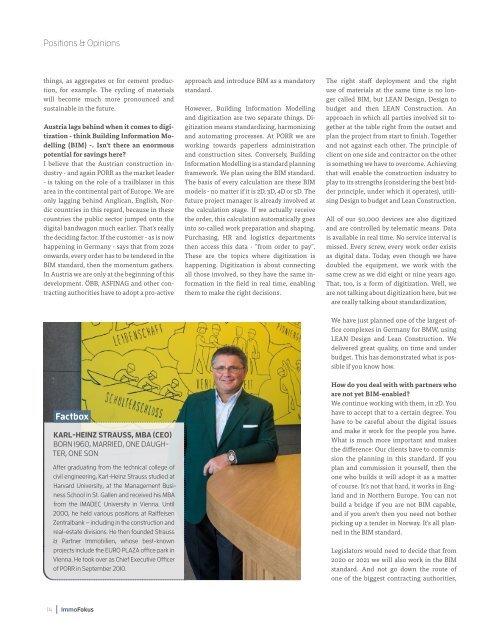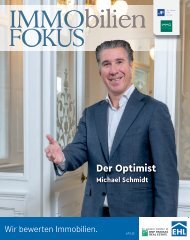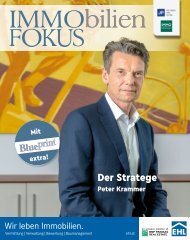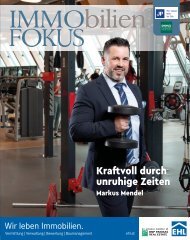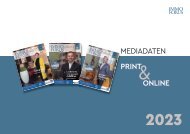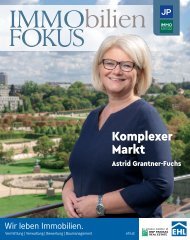MIPIM 2019 (24.1 MB)
Create successful ePaper yourself
Turn your PDF publications into a flip-book with our unique Google optimized e-Paper software.
Positions & Opinions<br />
things, as aggregates or for cement production,<br />
for example. The cycling of materials<br />
will become much more pronounced and<br />
sustainable in the future.<br />
Austria lags behind when it comes to digitization<br />
- think Building Information Modelling<br />
(BIM) -. Isn't there an enormous<br />
potential for savings here?<br />
I believe that the Austrian construction industry<br />
- and again PORR as the market leader<br />
- is taking on the role of a trailblazer in this<br />
area in the continental part of Europe. We are<br />
only lagging behind Anglican, English, Nordic<br />
countries in this regard, because in these<br />
countries the public sector jumped onto the<br />
digital bandwagon much earlier. That's really<br />
the deciding factor. If the customer - as is now<br />
happening in Germany - says that from 2024<br />
onwards, every order has to be tendered in the<br />
BIM standard, then the momentum gathers.<br />
In Austria we are only at the beginning of this<br />
development. ÖBB, ASFINAG and other contracting<br />
authorities have to adopt a pro-active<br />
approach and introduce BIM as a mandatory<br />
standard.<br />
However, Building Information Modelling<br />
and digitization are two separate things. Digitization<br />
means standardizing, harmonizing<br />
and automating processes. At PORR we are<br />
working towards paperless administration<br />
and construction sites. Conversely, Building<br />
Information Modelling is a standard planning<br />
framework. We plan using the BIM standard.<br />
The basis of every calculation are these BIM<br />
models - no matter if it is 2D, 3D, 4D or 5D. The<br />
future project manager is already involved at<br />
the calculation stage. If we actually receive<br />
the order, this calculation automatically goes<br />
into so-called work preparation and shaping.<br />
Purchasing, HR and logistics departments<br />
then access this data - "from order to pay".<br />
These are the topics where digitization is<br />
happening. Digitization is about connecting<br />
all those involved, so they have the same information<br />
in the field in real time, enabling<br />
them to make the right decisions.<br />
The right staff deployment and the right<br />
use of materials at the same time is no longer<br />
called BIM, but LEAN Design, Design to<br />
budget and then LEAN Construction. An<br />
approach in which all parties involved sit together<br />
at the table right from the outset and<br />
plan the project from start to finish. Together<br />
and not against each other. The principle of<br />
client on one side and contractor on the other<br />
is something we have to overcome. Achieving<br />
that will enable the construction industry to<br />
play to its strengths (considering the best bidder<br />
principle, under which it operates), utilising<br />
Design to budget and Lean Construction.<br />
All of our 50,000 devices are also digitized<br />
and are controlled by telematic means. Data<br />
is available in real time. No service interval is<br />
missed. Every screw, every work order exists<br />
as digital data. Today, even though we have<br />
doubled the equipment, we work with the<br />
same crew as we did eight or nine years ago.<br />
That, too, is a form of digitization. Well, we<br />
are not talking about digitization here, but we<br />
are really talking about standardization,<br />
We have just planned one of the largest office<br />
complexes in Germany for BMW, using<br />
LEAN Design and Lean Construction. We<br />
delivered great quality, on time and under<br />
budget. This has demonstrated what is possible<br />
if you know how.<br />
Factbox<br />
KARL-HEINZ STRAUSS, <strong>MB</strong>A (CEO)<br />
BORN 1960, MARRIED, ONE DAUGH-<br />
TER, ONE SON<br />
After graduating from the technical college of<br />
civil engineering, Karl-Heinz Strauss studied at<br />
Harvard University, at the Management Business<br />
School in St. Gallen and received his <strong>MB</strong>A<br />
from the IMADEC University in Vienna. Until<br />
2000, he held various positions at Raiffeisen<br />
Zentralbank – including in the construction and<br />
real-estate divisions. He then founded Strauss<br />
& Partner Immobilien, whose best-known<br />
projects include the EURO PLAZA office park in<br />
Vienna. He took over as Chief Executive Officer<br />
of PORR in September 2010.<br />
How do you deal with with partners who<br />
are not yet BIM-enabled?<br />
We continue working with them, in 2D. You<br />
have to accept that to a certain degree. You<br />
have to be careful about the digital issues<br />
and make it work for the people you have.<br />
What is much more important and makes<br />
the difference: Our clients have to commission<br />
the planning in this standard. If you<br />
plan and commission it yourself, then the<br />
one who builds it will adopt it as a matter<br />
of course. It's not that hard, it works in England<br />
and in Northern Europe. You can not<br />
build a bridge if you are not BIM capable,<br />
and if you aren't then you need not bother<br />
picking up a tender in Norway. It's all planned<br />
in the BIM standard.<br />
Legislators would need to decide that from<br />
2020 or 2021 we will also work in the BIM<br />
standard. And not go down the route of<br />
one of the biggest contracting authorities,<br />
14 ImmoFokus


